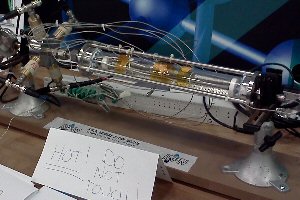Corrections to Celani-Letts Demo Article

Sept 12, 2012 – By Steven B. Krivit –
On Aug. 7, 2012, we reported a LENR demonstration on Aug. 6 at the National Instruments trade show in Austin, Texas. We have some corrections and additions to that story.
The demonstration was designed by Francesco Celani, a physicist with the Italian National Institute of Nuclear Physics in Frascati, Italy. Celani built and tested the experiment in his Frascati laboratory and brought it to Austin. Dennis Letts, an independent Austin, Texas-based LENR researcher, assisted Celani with the demonstration and reported the story to us. Celani did not respond to our request for comment the day we wrote the story, but after it published, he reviewed the story and provided the following corrections.
1. Celani wrote that the wire used was a nickel alloy, not pure nickel.
2. Celani wrote that the experiments took place in the city of Frascati, a suburb of Rome, not Rome proper.
3. Celani provided additional details about the experiment: "The experiment uses a thin (apparent diameter 0.22mm) wire, an alloy based on Cu-Ni-Mn, that is enclosed in a glass chamber. The starting alloy is the commercial Constantan with the specific composition of Cu55%, Ni44%, Mn1%. Most of the surface of the wire (about 40 percent of total volume) is sub-micrometric in thickness, thanks to innovative treatments performed by [me] and some of [my] collaborators. The glass chamber is filled with hydrogen gas. Typically, the hydrogen sits in the chamber for about three days as it approaches steady-state, and absorbs, or loads, into the nickel alloy. Excess heat begins to appear (at low levels) after the first loading period (less than 1 hour) and increases as the loading increases."
4. Celani wrote that, for the demonstration in Austin, he had loaded and made several experiments with the nickel alloy wire (#2) for several weeks, not only three days, before bringing it to Austin.
The report shown at ICCF17, wire #2, is based on the experiment started on July 10.
5. When Celani and Letts tested the reactor in Letts’ lab on Sunday night, they did not shut it off at midnight but let it run overnight. On Monday morning, they came back to the lab, stopped the reactor and, after it cooled, pressurized it with some additional hydrogen, and brought the reactor into the convention center.
6. Celani wrote that the experiment did, in fact, run for a period in the Letts laboratory on Sunday night during the loading period to show a baseline.
7. Celani wrote that there was a minor incubation period on Monday, rather than no incubation period, when they turned it on in the convention center. The wire had been sufficiently reloaded during the previous night as well as on Monday morning so that the anomalous heat began much faster.
8. Celani wrote that they started the demonstration in the convention center at 10:56 a.m. on Monday and that they did not turn it off when they went home that evening at 7 p.m. but left it running.
9. Our quote from Letts that stated that Celani has a way to check the system with another wire that goes into the cell is incorrect. There is no such wire.
New Energy Times thanks Francesco Celani and Dennis Letts for their assistance.

